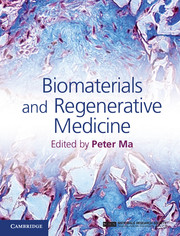Book contents
- Frontmatter
- Contents
- List of contributors
- Preface
- Part I Introduction to stem cells and regenerative medicine
- 1 Embryonic stem cells
- 2 Induced pluripotent stem cells
- 3 Connective tissue stem and progenitor cells
- 4 Hematopoietic stem cells and their niches
- 5 Using biomaterials for fetal stem cell isolation, expansion and directed-differentiation
- 6 The hematopoietic stem cell niche
- Part II Porous scaffolds for regenerative medicine
- Part III Hydrogel scaffolds for regenerative medicine
- Part IV Biological factor delivery
- Part V Animal models and clinical applications
- Index
- References
4 - Hematopoietic stem cells and their niches
from Part I - Introduction to stem cells and regenerative medicine
Published online by Cambridge University Press: 05 February 2015
- Frontmatter
- Contents
- List of contributors
- Preface
- Part I Introduction to stem cells and regenerative medicine
- 1 Embryonic stem cells
- 2 Induced pluripotent stem cells
- 3 Connective tissue stem and progenitor cells
- 4 Hematopoietic stem cells and their niches
- 5 Using biomaterials for fetal stem cell isolation, expansion and directed-differentiation
- 6 The hematopoietic stem cell niche
- Part II Porous scaffolds for regenerative medicine
- Part III Hydrogel scaffolds for regenerative medicine
- Part IV Biological factor delivery
- Part V Animal models and clinical applications
- Index
- References
Summary
Introduction
Hematopoietic stem cells (HSCs) are a type of adult stem cell that give rise to all cells in the blood lineage. In adult mammals, they reside in the spongy bone marrow of the long bones. HSCs are not only the most widely studied stem cells, but also the most common cells used in transplantation in the clinic. Since blood is the most commonly transplanted tissue in clinical settings, this makes HSCs an important candidate in establishing better treatments for hematological malignancies.
They have been widely studied for the last 40 years, and the literature on HSCs covers a diverse range of topics. Since it is impossible to cover all aspects of HSC biology in one chapter, here we will focus briefly on the origins of HSCs and their microenvironments, or niches, the isolation methods of HSCs, the standard assays for detection of HSC activity, in-vitro expansion of HSCs, their clinical relevance, and the potential role of the HSC niches in cancer metastases.
- Type
- Chapter
- Information
- Biomaterials and Regenerative Medicine , pp. 44 - 63Publisher: Cambridge University PressPrint publication year: 2014
References
- 1
- Cited by



